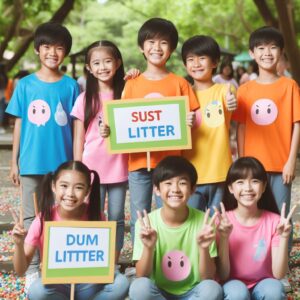Chewing gum is a non-biodegradable product made from synthetic plastics and resins, which means that it persists in the environment and contributes to urban litter. The persistent presence of gum litter in public spaces costs millions annually to clean up and is a substantial distraction from the beauty of our towns and cities.
Children can play a role as environmental stewards, engaging in activities today that are angled towards safeguarding the world of tomorrow. Educating children about responsible habits such as the proper disposal of waste can instill positive habits that will be passed on to subsequent generations.
A child educated about environmental issues can act as a conduit to relay this information to adults in their family, neighborhood, and larger community. This ripple effect can lead to increased environmental awareness and proactive measures in a community.
Studies have shown that children possess the ability to internalize educational concepts effectively, particularly when it concerns issues relating to their world. Children can absorb, retain, and practice the teachings related to environmental stewardship.
Childhood experiences greatly shape our adult perspective. Early exposure to nature, environmental conservation, and sustainability can lay the foundation for a generation more attuned to protecting our planet.
 Educating Children About Litter
Educating Children About Litter
One fundamental step is informing children about what littering is and explaining why it’s harmful. This learning process can start at home or in school by painting a clear picture of the environmental consequences littering brings, specifically discussing non-biodegradable substances like chewing gum. By fostering a complete understanding, children can see the connection between their actions and their impact on the environment.
Engaging children in activities such as litter picking can provide them with first-hand experience of the quantity and impact of waste disposed improvidently into our environment, including discarded gum. This leaves lasting impressions, motivating kids to make better waste disposal choices.
Lessons about waste management, recycling, and the impact of litter, particularly non-biodegradable substances, form a concrete understanding of how each individual’s actions contribute to overall environmental health.
Movies and books with a relevant theme can aid in educating children about litter. These resources often simplify complex issues, making them easy to digest and comprehend for younger minds while retaining their attention and interest.
Interactive mobile applications or online platforms encouraging children to learn about litter, its impact, and waste management methods can make the educational process more interactive and engaging, targeting even the youngest in the digital age.
The adults in their lives have the responsibility to practice and demonstrate proper littering habits. The act of habitually carrying gum wrappers or finding a proper bin for gum disposal reinforces the lessons being taught.
Motivating Children to Act
Reward systems have proven to be an effective motivational tool for children. They can be privileges, praise, or recognition. A ‘cleanest classroom’ accolade or a ‘best eco-practices student’ badge can incentivize children to adopt better litter management practices. Such systems can promote active participation, responsibility, and accountability.
Regular validation and encouragement of their efforts towards responsible habits, like properly discarding gum wrappers, can instill a long-lasting practice of these behaviors. It also strengthens their belief that their actions matter.
Creating opportunities for collective action, such as classroom projects or community campaigns on litter management, harnesses the power of group dynamics to yield positive behavioral changes. Children who observe their peers acting responsibly may be prompted to mirror those behaviors.
Allowing room for independence and decision-making about simple tasks increases their sense of self-efficacy. Children who feel empowered are more inclined to take initiative, such as following through on their knowledge of proper litter disposal practices.
Influencing Change through a Child’s Perspective
A child might suggest unique ways to repurpose or dispose of gum wrappers, arousing considerable interest in innovative waste management methods. Schools, homes, and communities have the responsibility to create platforms where children can voice their concerns, ideas, or solutions. Children can present their opinions on litter management during a school presentation or a local community meeting, encouraging dialogue and potentially initiating change.
Incorporating children’s views in education curriculums and initiatives promotes inclusivity and mirrors a society that values all its members’ contributions. Children’s original ideas can stimulate novel strategies for combating problems like gum litter.
Enabling children to act in leadership roles or participate actively in decision-making processes can also precipitate notable change. When children understand that they can contribute significantly to their environment, it nurtures a sense of responsibility and a desire to affect positive change, which they carry into adulthood.
Providing Alternatives
Public places, institutions, or even households could make appropriate disposal containers available, significantly reducing the likelihood of improper disposal. Schools can install these containers in classrooms or common areas, serving as a constant reminder for students to dispose of litter responsibly.
Biodegradable or edible gum types of gum, being designed to minimize environmental impact, can gradually replace regular gum. It could provide a greener alternative to traditional gum, aligning with efforts towards a more sustainable environment.
It’s important to provide alternatives that encourage responsible behavior and discourage detrimental practices. Introducing penalties for gum littering can deter people from inappropriate disposal of gum. Rewarding responsible behavior could incentivize proper gum disposal, further emphasizing the effect of good habits.
Innovative technologies and initiatives could be harnessed to provide alternative solutions. Leveraging art projects that reuse gum wrappers can transform waste into valuable resources. This alternative fosters creativity and innovation among children.
Scaling Impact
If a particular school has successfully reduced gum litter through a specific initiative, such as using designated bins for gum disposal, this practice can be replicated in other schools, communities, or even countries. Sharing success stories and practices can inspire others and contribute towards a larger, collective impact on reducing gum litter.
By working together, organizations, communities, or countries can pool resources, ideas, and influence to create more significant change. A partnership between schools, local businesses, and non-governmental organizations can facilitate larger clean-up drives or other gum litter reduction initiatives, enhancing impact and reach.
Digital platforms can be used to spread awareness about problems associated with gum litter, share successful interventions, and even mobilize action at a global level. Mobile apps could be developed to educate users or report areas heavily affected by gum litter.
Governmental bodies and private entities can provide funding for scientific research to develop more environment-friendly alternatives to traditional gum. Policy changes can enforce stricter regulations on gum disposal, thereby impacting a wider population.



